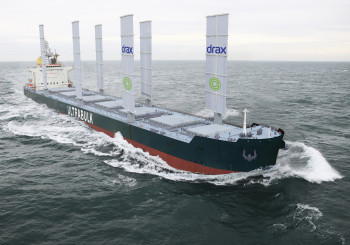
HYD & climate action on shipping
— 26 Apr 2021

The UK Government is the first to mandate emissions reductions in the shipping sector, and from our experience this is absolutely necessary to force serious attention by an industry which is very conservative by nature and fragmented in its ownership structure and responsibilities. In many ways the shipping industry is a paradox: 90% of the ‘things’ we use in our daily lives has a voyage as part of its distribution, yet shipping has escaped attention by both Kyoto and Paris protocols. But the sector is responsible for 3% of global emissions, a figure which is growing rapidly as other sectors manage to rein in their emissions when shipping continues to grow unharnessed.
By ‘our experience’, we mean that we have been integrally involved with Smart Green Shipping for over 10 years as the group naval architects, and both Rob and Tom have had first hand access to some major UK docks in that time, mindful that any efficiency gains out on the ocean must also be user-friendly from a cargo-handling perspective.
In all that time we have been part of intensive discussions with establishment names such as Rolls Royce, Cargill, Ultrabulk, Drax and others, and while it is absolutely true that the right noises are being made it was always clear that legislation was the only way to convert good intention into actionable development.
SGS, led by Diane Gilpin, recently completed the successful validation of a retrofitted multiple wing-sail configuration on a Panamax ship, running a trans-Atlantic route delivering biomass for Drax. With the 12 month project funded through Innovate UK, HYD led the design development, assigning the Wolfson Unit of Southampton University to carry out this validation process, and we got AES of New Zealand involved to look after the engineering aspects. AES’ Chris Mitchell is arguably one of the world’s most eminent spar engineer, with experience ranging between America’s Cup and various endurance projects. To cut a long story short, the conservative conclusion that the wing rigs developed returned over 20% reduction in fuel burn, generating both operating cost and emission savings.
Obviously, there are other developments coming down the track, such as hydrogen, methane, etc., but whatever other gains are made wind will always be available, albeit in various forces of supply but, as Di puts it, free at the point of delivery.
With encouraging announcements by Boris Johnson, Joe Biden and others it seems that the world’s media is suddenly engaging more seriously, and the article below in Wednesday’s (21st April 2021) Times is a case in point, as is the BBC feature (linked below). The headline image used by The Times is of a mid-range vessel we worked on a few years ago for an Expo promotion featuring an industrialised Dynarig derivative
The Times - April 2021 - attaching-giant-sails-to-cargo-ships-could-slash-their-greenhouse-gas-emissions

BBC News - Di Gilpin - Interview
The BBC interview, aired on the same day, features Diane Gilpin explaining the issues, and starts at about 11 minutes into the news programme, after the football. Priorities!!
